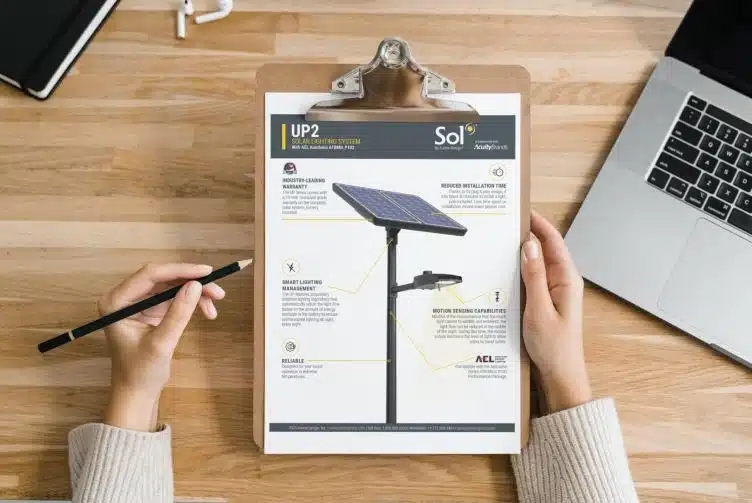Â
So, you’ve decided to use solar lighting on your next project. That’s exciting! Now comes the tricky part: choosing the right product and manufacturer.
Â
Shopping for solar lighting isn’t like buying an air fryer or a smartwatch. There's no Wirecutter or CNET to guide you. Instead, you'll find yourself looking at spec sheets—those detailed documents that hold all the information needed to compare products and make an informed decision.
Â
But what exactly is a spec sheet? It’s a technical document that outlines key specifications of a product, such as its performance, durability, and compliance with standards. These sheets can be overwhelming, but they're essential when it comes to solar lighting systems.
Â
Understanding these sheets is crucial because not all specs are created equal. Some numbers might seem impressive, but without context, they can be misleading. Let’s break down what you need to know to navigate them effectively.
Â
The info you actually need
Â
Here’s the good news: You don’t need to understand every detail on a spec sheet to make a smart purchase. Focus on the four most important metrics:
- Solar panel size (in Wp – watt-peak)
- Fixture output (in watts – W)
- Battery capacity (in Wh – watt-hours)
- Operating profile or run-time (how long the system needs to run and at what light level)
These will help you determine if a system is suitable for your project. If one of these details is missing, it could signal a red flag, so always double-check.
Â
For example, if you’re in Charlotte, NC, and you want to power a 30W fixture for 14 hours, you’ll need to calculate how much energy your solar panel can generate and how much battery storage you’ll require.
Â
Solar panel collection
Â
To find out how big your solar panel should be, start by checking the average number of peak sun hours in your area. The NREL PVWatts Calculator is a great tool for this. For Charlotte, that’s about 3.73 hours in December.
Â
Multiply that by the panel size in Wp to get the daily charging capacity. But remember, peak sun hours vary, so it's wise to include an array-to-load ratio (ALR) of 1.2:1 to account for less-than-ideal conditions.
Â
This helps ensure your system can recover from low-light days. A reputable manufacturer will also factor in derating for real-world conditions like dust, snow, and temperature changes.
Â
Fixture output and operating profile
Â
Once you know how much energy is available, you need to calculate how much your fixture will consume. Use the longest night of the year to determine the load. For Charlotte, that’s 14 hours.
Â
If your fixture uses 30W, the total energy required would be 420Wh. If your solar panel can only provide 341Wh, you may need to adjust the operating profile—like dimming the light in the middle of the night—to stay within limits.
Â
Battery capacity and chemistry
Â
Batteries are crucial for ensuring your system runs smoothly over multiple days. Lead-acid and lithium batteries have different depths of discharge (DOD), which affects their lifespan and performance.
Â
A lithium battery can be discharged up to 70%, while lead-acid should only go to 25%. This means you’ll need more capacity for lead-acid batteries to maintain the same runtime.
Â
Other considerations
Â
Warranty
Even with grants, solar lighting is still a major investment. Look for a comprehensive warranty, especially on the battery. Some manufacturers offer limited warranties, so always check what is covered.
Â
Certifications and testing standards
Independent certifications like IEC and IEEE can give you confidence in a product’s quality and safety. LM-79 testing is particularly useful as it verifies the performance of the entire fixture, not just individual components.
Â
Fixture characteristics
Some manufacturers build their own fixtures, while others use third-party components. Understanding where your fixture comes from can help you assess its quality and reliability.
Â
Wrapping up
Â
Reading and comparing solar lighting spec sheets doesn’t have to be overwhelming. With the right knowledge, you can make confident decisions and choose the best system for your needs.
Â
Have questions about spec sheets or anything else? Our team of solar lighting experts is here to help. Contact us today!
Â
Sheet metal enclosures are protective casings made from sheet metal materials. They are commonly used in various industries to house electronic components, machinery, and other equipment. These enclosures provide a secure and durable housing solution that protects the internal components from external elements such as dust, moisture, and physical damage.We can also privide Sheet Metal Enclosures,Plastic Machining Rapid Prototyping,Enclosure Electronic Component Prototyping,Abs Enclosure Prototype.
Sheet Metal Enclosures,Plastic Machining Rapid Prototyping,Enclosure Electronic Component Prototyping,Abs Enclosure Prototype
JING SUNG Precision CO., , https://www.jingsungcnc.com
